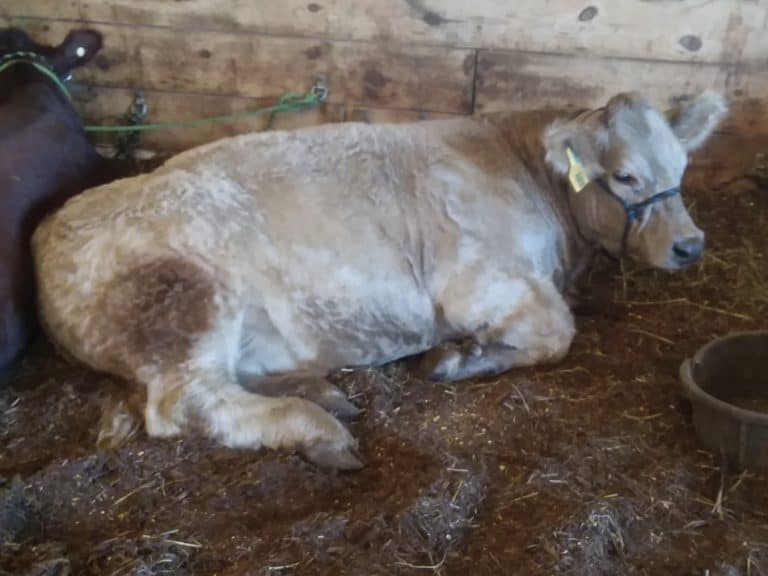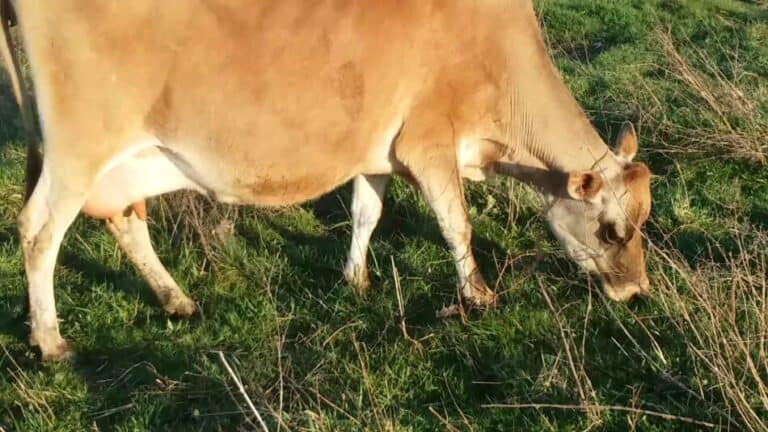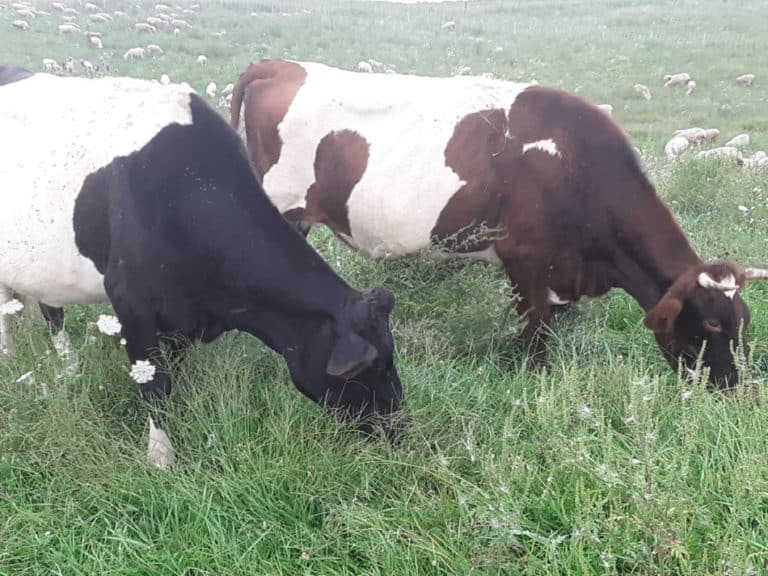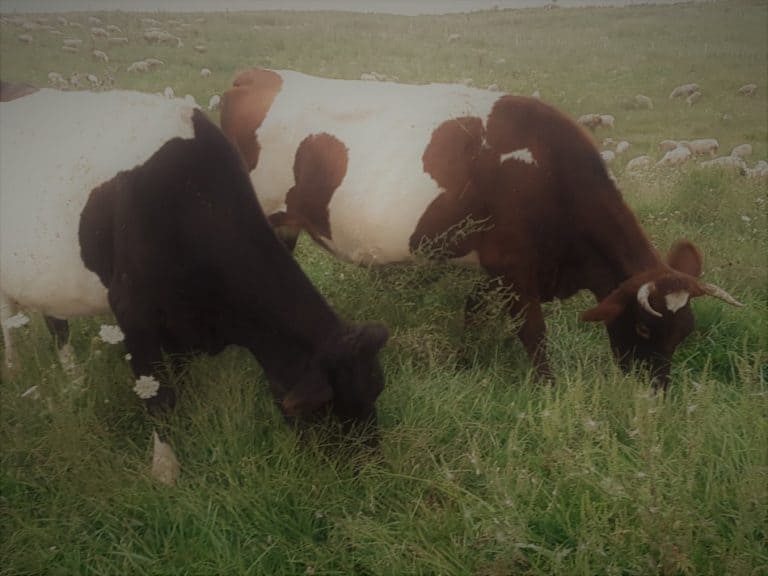Beef Quality: What Makes The Most Flavorful Results

We all want the best tasting beef we can get! Often, it is confusing to sort through the opinions and propaganda to get to the results.
What are the factors that really affect the taste of your beef?
The most flavorful beef comes from animals that are raised in a low stress environment, are treated well, are healthy and have ample forage to eat.
If you are going to put in the time to raise your own beef, it might as well taste wonderful, right? I agree. Let’s dig into how you can raise the best beef you’ve ever had!
Cost To Buy A Starter Beef Herd goes over your options and places to start doing price research when getting started with beef cattle.
Diet affects taste of the beef
You are what you eat, a familiar saying that is just as true for cattle as it is for you.
I would like you to consider that all beef should be amazing, tons of flavor from an animal that had a great life.
This is the steer (castrated male bovine) at the pinnacle of taste and anything less is an animal living below it’s potential.
We are told that for extra flavor you have to add …. (fill in the blank with whatever suits you), but I think that you don’t need to add anything.
Great tasting meat stands alone.
I’m not anti sauce, not at all. I love them, especially barbeque, but I am opposed to needing the sauce to make up for lack luster flavor.
It makes more sense to start out with great flavor and add to it vs. trying to make up for a deficit.
Cost To Butcher Your Own Beef goes over your costs to get your steer into the freezer.
Beef flavor comes from forage variety
The most flavor in beef comes from cattle that are eating a variety of forages.
Ideally, a mix of grasses and forages (plants that are eaten by livestock but not just grasses) to give the steer the wide range of nutrients he needs for optimal health.
Think of all the forages that make hay, like alfalfa, orchard grass, timothy, clovers, along with herbs and “weeds” like chicory, plantain, ragweed, goldenrod and many others.
The steer should eat what grows in your area. It’s really that easy.
Raising Beef Cattle On Grass will show you some of the things you need to know to manage your grass fed cattle.
Steers are ruminants so need forages for gut health
The best flavor comes from animals getting a full spectrum of nutrients, the ones you know about and the ones that we don’t hear about that are available in plants.
Remember, since you are feeding a ruminant here, the actual eaters are all of the bacteria in the gut.
The best health and most widely available food source for the steer and his legion of gut bacteria is forage.
This could include occasional grain, but not grain as a main part of the diet.
There is nothing wrong with animals eating grain.
However, cattle are ruminants. That means they need lots of forages to make their digestive system work properly and don’t need grain at all.
They like it but they don’t need it. An all grain or high grain diet gives them an upset stomach, just like a kid eating too much candy.
Stress affects growth and beef flavor
Stress is a resource hog.
A stressed animal has to use nutrients and energy that should be going into repair and growth and instead use them for “fight or flight”.
Since stress is internally an immediate threat (read threat to life), the steer will naturally put off or delay other processes that won’t help it survive the looming danger.
Things like maintaining the immune system get put on hold, even if the looming danger is not actually life threatening, it just has to be regarded as such by the body.
A happy steer will grow at the most efficient rate and produce the best meat. A big part of being happy is living in a low stress environment.
This is true, once again, for you as well as all other animals.
Low stress living will have the steer using the majority of his body’s resources for upkeep of his immune system, maintaining a healthy fat cover, body growth and general maintenance and repair.
This will naturally grow the healthiest animals and provide the set up for optimal growth of the animals.

Fast growth does not equal beef flavor
Generally speaking, fast growth does not equal the most or best flavor.
I’m not saying the flavor from fast growing animals is bad, but it is not what that beef could have been had the steer been raised differently.
The flavor from a steer raised in a more traditional way and with traditional feeds/forages will have more flavor and that flavor will have more depth.
Older steers have more flavor
The simple explanation here is likely to be age. An older animal, of any type, will have more flavor and a younger one less flavor.
The trade off here (there’s always a trade off) is a younger animal is usually more tender than an older one.
To be clear a good (read fast) growth rate is important, slow growers are not economical to raise, but good/fast growth is a relative term.
The fastest growing cattle are strictly grain fed in an industrial system, that’s not the good kind of fast growth.
Cattle need forages to be digestively healthy
Why not? Because biologically, cattle are ruminants, ruminants need forages (plant fiber) to have a properly functioning digestive system.
No forages=not good for cattle, no matter how fast they grow. Think of an obese 8 year old, that kid grew fast, too.
We as cattle raisers want good growth rates while keeping the system ideal for cattle, meaning not a feed lot.
Cattle can be put in industrial production systems and gain faster than traditional systems, but it is good for the cattle?
Ultimately, whatever is good for the cattle is good for the cattle raiser and good for the cattle eater.
Cattle breed selection does matter
As long as you are choosing to raise a breed, or mix of breeds (called a crossbred), that is appropriate for your area, you or your farmer should be set up to produce the best flavor possible.
Match the cattle breed to the local conditions
Here is an example: A breed known for it’s hardiness and cold tolerance is the Scottish Highland.
They are beautiful and pretty easy keepers, we had some 15 or so years ago. Highlands are a smaller cow that’s big on horns and hair!
Highlands would be a poor choice for a tropical cattle raiser, it’s too hot in the tropics for this breed.
A tropical cattle raiser needs a breed with superior heat tolerance and insect resistance. There are other breeds like brahmas that would work great.
Use cattle suited to your area
As long as the cattle breed or mix of breeds is workable for your situation then really the more important factor is method the steers are raised in and diet.
There are breeds that have certain characteristics like more marbling in the meat or a wider framed body, but overall as long as the animal is suited for the area there are at least a few great choices, genetics wise.
Wondering what breeds of cattle might be a good fit for you? Read my article 14 Docile Breeds Of Beef Cattle.
There is breed specific beef available
Breed is also a factor in area specific meat production like Label Rouge.
This is a French program that certifies meat raised in a specific way starting with a specific breed or breeds that are originally from the area.
Kind of like Certified Angus Beef, not all cattle sold in America meet the criteria for this program, the same with Label Rouge.
The point is to consider your farm or your local growing area and your resources.
Match the natural characteristics of the cattle to the specific needs and challenges of your area and growing conditions.
The savvy cattle raiser takes advantage of this opportunity.

The steers that will do best in your area are ones that naturally like the conditions your area has available.
Since all areas are different it only follows that different areas and management systems will do best with different cattle.
Terroir: unique flavor from a specific location
noun. the environmental conditions, especially soil and climate, in which grapes are grown and that give a wine its unique flavor and aroma: the high quality of the region’s terroir. Also called goût de ter.
dictionary.com
Terroir | Definition of Terroir at Dictionary.com
I know the quote is speaking to taste of wine specifically, but the same idea applies to any food, how it is raised will be apparent in the taste.
This is why in the EU place specific names for food are such a big deal, for instance the original Parmesan cheese, actually called Parmigiano Reggiano, can only come from Italy and a specific area of Italy at that.
Why? Because of the unique combination of environment and aging conditions of the area are need to make the real deal Parmesan cheese.
All others cheese makers are doing their best, but can never replicate the exact set up and therefore resulting cheese.
Parmigiano Reggiano cheese is named after the provinces in which it is made, namely Provinces of Parma, Reggio Emilia, Modena, Bologna and Mantua. True Parmesan cheese has a hard, gritty texture and is fruity and nutty in taste. Cheeses mocking Parmesan or inferior Parmesan may have a bitter taste.
Parmesan – Cheese.com
https://www.cheese.com/parmesan/
The same applies to any animal, range feed sheep, cattle and goats, for instance, are going to taste noticeably different than the same animals raised around here (Ohio).
Wine producers have recognized terroir for ages and it is true for all foods.
Here is the place to mention Label Rouge again, since it is a program that has a few critical pieces that all must be in place, how the animal was raised, the breed of the animal and the area in which the animal was raised.
Meaning genuine Label Rouge beef must be from a French breed, raised in France under certain conditions, like being on grass, etc.
Granted, Label Rouge’s flagship product is chicken, but the same thinking still applies.
So, what is the big deal here? Taste.
The best flavor comes from happy cattle
The proof is in the results, that’s the bottom line. Whatever your ideal cattle raising situation there are positives and negatives associated with that particular method.
Cattle with lots of room to move usually have to move, meaning there is a lot of walking involved to get to water and to find enough forage for daily calorie needs.
Cattle inside a more enclosed area, even just a smaller paddock, have less freedom of movement.
But they also have everything thing they need close and easy to reach, like plentiful grass and farmer provided water in troughs.
Happy cattle are calm and chew their cud
If you are fortunate enough to be able to visit your steer at his home farm before he goes to the butcher here are a few things to look for so you can tell if he is being treated well.
Remember good treatment of the animal equals good eating qualities.
- Hair coat-cattle in good health naturally have a nice smooth, shiny hair coat
- Demeanor-interested in you and active, eating or chewing cud-try to spy on them before they see you so you see their normal activities
- Surroundings-overall how do things look? How do things smell? New doesn’t matter, cattle friendly environment does matter
At a farmer’s market or a natural foods store? Look at pictures and see what you can find online.
Farms that want your business and are providing exceptional quality beef are proud to show you their cattle and the way they raise them.
If you can’t get the pictures or video-ask, maybe the farmer just didn’t realize customers would want to see a video.
Or they are uncomfortable with video and unaware of the difference it would make for their sales.
While we do not currently attend farmer’s markets, this “avoid technology” person would have been me as recently as six months ago.
Give the farmer the benefit of the doubt and just ask.
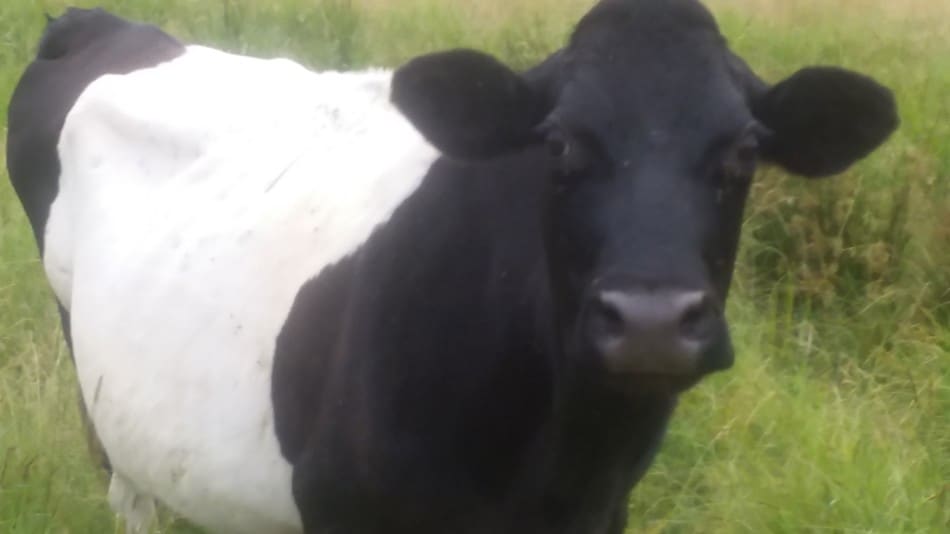
Age and marbling affect beef flavor
- Age of steer
- Aging of the meat
- Variety of the animal’s diet
- Marbling of the meat
- Exercise in the steer’s daily life
Age of the steer– older animals have more flavor. This is true of any animal. Most cattle are sent to market at the best balance of size and age.
The longer you keep a steer the more it costs to raise but the bigger it will be (up to a point) when it sells.
Aging of the meat-beef needs to hang (age in a meat locker/cooler) for 2 weeks before the carcass is cut up into the steaks and roasts that you want for your freezer.
Aging allows the bacteria (good bacteria that are naturally in the air) some time to break down the meat a little. This is all about tenderness.
Beef does not need to be aged to be eaten, but if you want tender beef aging is a crucial step.
Variety of the steer’s diet-the more variable the grasses, forbes (shrubs), herbs, “weeds” and other forages that the animal had available to eat the more flavorful the meat will be.
This is why you can find beef from Texas that has the selling point of the steer grazing on mesquite and therefore giving the meat a special flavor.
Corn fed will taste different than grass fed. Range fed will taste different than pastured in Ohio (where we live).
None of these feed choices are better or worse than the other as long as the animal is healthy.
The only rule here is that cattle are ruminants, meaning they are made to eat forages.
Exclusively feeding grain is not good for the animal’s digestive system therefore not good for it’s overall health.
Find local beef with great flavor
An easy first step to eating beef with great flavor is to shop as locally as possible.
Locally produced meat will have more flavor, since the steer did not have to be trucked very far (trucking is stressful).
When you find multiple choices for buying local beef, now you can be more specific in your requirements.
If you can only find one source, either look harder or go with it, since locally raised just makes more sense compared to an animal raised far away and trucked all over the place.
If no one in your area raises beef, then get some from a butcher shop that buys local beef sourced from as close as possible, but definitely within your state.
Check online ads or put up an ad yourself online or at the local stores that sell cattle supplies.
If you have a local livestock auction, look there or ask at your local butcher shop.
Beef takes more time and money to raise
The short version on cost of beef (or any food): The more resources that are put into the finished product, the more it will cost.
A biggie here is time, it is an easy one to overlook but a huge factor, especially with animals.
To grow out a steer for you on grass alone will take at least 6 months longer than a grain feed steer.
For the same weight, the farmer has to put off payday for 6 more months than if the steer was fed in a way that promoted faster, yet less healthy, growth.
For a steer raised industrially and pushed for maximum growth on a very high grain ration, the time difference would be even longer.
Time is money, so more time and/or other resources (don’t forget to include the cost of the grazing, grass is not free!) spent to produce the beef equals more cost for the beef when is is sold. It is basic economics.
For the eaters: So you want better tasting beef? You’re going to have to pay more, but that’s only right because you are getting more.
For the cattle raisers: You want to produce great tasting beef? Give your cattle a great life. Wonderful, full flavored beef comes from cattle that have a wonderful, full life.
